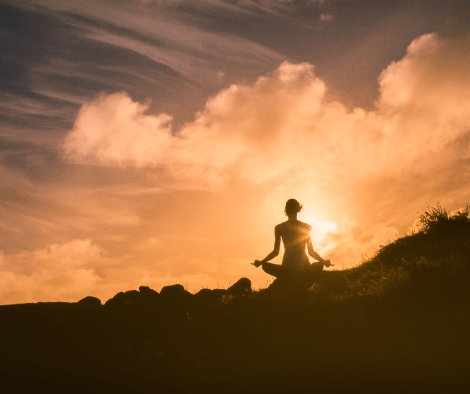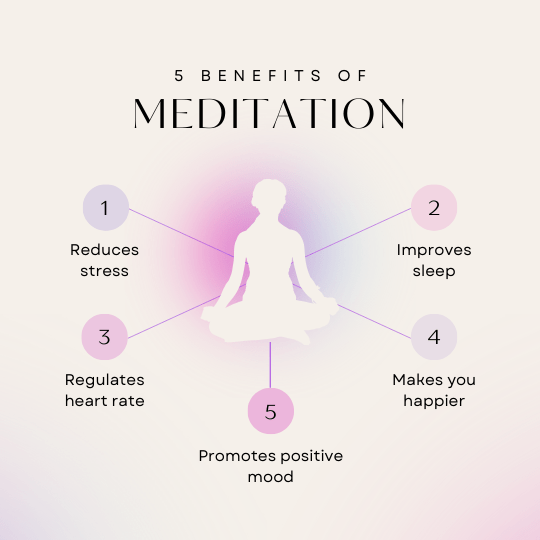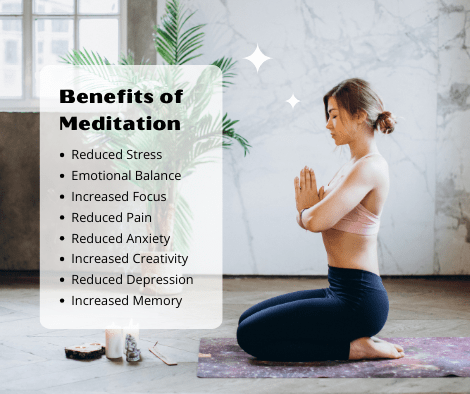Practice of Meditation : Meditation is a practice that involves focusing the mind and cultivating a state of inner peace, awareness, and mindfulness. It encompasses various techniques and traditions, but at its core, meditation involves directing attention inward, observing thoughts, emotions, sensations, or the breath, and allowing them to arise and pass without judgment.
Practice of Meditation : The practice of meditation dates back thousands of years and is found in various spiritual and religious traditions, including Hinduism, Buddhism, Jainism, Taoism, and Christianity, among others. However, meditation has also gained popularity in secular contexts as a means of reducing stress, enhancing well-being, and improving mental clarity.

Practice of Meditation :
Practice of Meditation : There are numerous forms of meditation, each with its unique techniques and objectives. Some common types of meditation include:
Mindfulness Meditation: In mindfulness meditation, practitioners focus their attention on the present moment, observing thoughts, sensations, and emotions as they arise without attachment or judgment.
Breath Awareness Meditation: This involves focusing on the breath as a point of concentration. Practitioners observe the natural rhythm of the breath, bringing attention back to the breath whenever the mind wanders.
Loving-kindness Meditation: Also known as Metta meditation, this practice involves cultivating feelings of love, compassion, and goodwill towards oneself and others. Practitioners repeat affirmations or phrases to generate feelings of loving-kindness.
Transcendental Meditation (TM): TM is a technique where practitioners repeat a mantra silently to themselves, allowing the mind to settle into a state of deep relaxation and inner peace.
Guided Visualization: In guided meditation, practitioners follow verbal instructions or imagery provided by a guide or teacher to evoke relaxation, stress reduction, or personal transformation.
Body Scan Meditation: This practice involves systematically scanning the body from head to toe, bringing awareness to different parts of the body and any sensations that arise.Walking Meditation: In walking meditation, practitioners cultivate mindfulness while walking slowly and deliberately, paying attention to each step and the sensations of movement.
Read More 👇
Fujifilm AI Endoscopy System Gets FDA Nod, Rivals Medtronic
Practice of Meditation : Meditation is a simple yet profound practice that can be tailored to suit individual preferences and needs. Here’s a general guide on how to meditate:
Find a Quiet and Comfortable Space: Choose a quiet and peaceful environment where you won’t be disturbed. Find a comfortable sitting position, either on a chair or cushion, with your back straight but relaxed.
Set a Time Limit: Decide on a duration for your meditation session. Beginners may start with just a few minutes and gradually increase the duration as they become more comfortable with the practice.

Close Your Eyes or Soften Your Gaze: Close your eyes gently or soften your gaze by lowering your eyelids. This helps reduce distractions and directs your focus inward.
Focus on Your Breath: Bring your attention to your breath. Notice the sensations of the breath as it enters and leaves your body. You can focus on the rise and fall of your chest or the sensation of air passing through your nostrils.
Be Present: As you focus on your breath, allow yourself to be fully present in the moment. Notice any thoughts, sensations, or emotions that arise without judgment or attachment. If your mind starts to wander, gently bring your attention back to your breath.
Use a Mantra (Optional): Some people find it helpful to use a mantra or phrase to anchor their attention during meditation. You can silently repeat a word or phrase, such as “peace” or “calm,” with each breath.
Practice Non-Attachment: Let go of any expectations or judgments about your meditation experience. Accept whatever arises during your practice with openness and curiosity.
End Mindfully: When your meditation session is complete, take a few moments to transition back to your everyday awareness. Gently open your eyes if they were closed and take a few deep breaths. Notice how you feel after meditating and carry this sense of mindfulness into your day.
Consistency is Key: Regular practice is essential for developing proficiency in meditation. Aim to meditate daily, even if it’s just for a few minutes. Over time, you’ll likely notice the benefits of meditation permeating into various aspects of your life.

Inner Technology:
Practice of Meditation : meditation can be considered as a form of “inner technology” in the sense that it provides tools and techniques for exploring and harnessing the power of the mind, consciousness, and inner experiences. While traditional technology focuses on external tools and mechanisms to enhance human capabilities, meditation focuses on internal practices that cultivate mental clarity, emotional balance, and spiritual insight.
Practice of Meditation : Here’s why meditation can be seen as an inner technology:
Mind Training: Meditation involves training the mind to become more focused, calm, and present. Through various meditation techniques, individuals learn to observe their thoughts, emotions, and sensations with greater clarity and non-reactivity.
Brain Plasticity: Research has shown that regular meditation can lead to structural and functional changes in the brain, a concept known as neuroplasticity. By engaging in meditation practices, individuals can rewire their brains to enhance cognitive functions, emotional regulation, and overall well-being.

Stress Reduction: Meditation has been scientifically proven to reduce stress levels by activating the body’s relaxation response and lowering levels of stress hormones like cortisol. By practicing meditation regularly, individuals can build resilience to stress and cultivate a greater sense of inner peace and calm.
Emotional Regulation: Meditation helps individuals develop greater emotional intelligence and resilience by allowing them to observe and understand their emotions more clearly. This can lead to improved self-awareness, empathy, and the ability to respond to challenging situations with equanimity.
Spiritual Exploration: For many people, meditation serves as a tool for spiritual exploration and self-discovery. By delving into the depths of their consciousness through meditation, individuals may experience profound states of interconnectedness, transcendence, and spiritual awakening.

